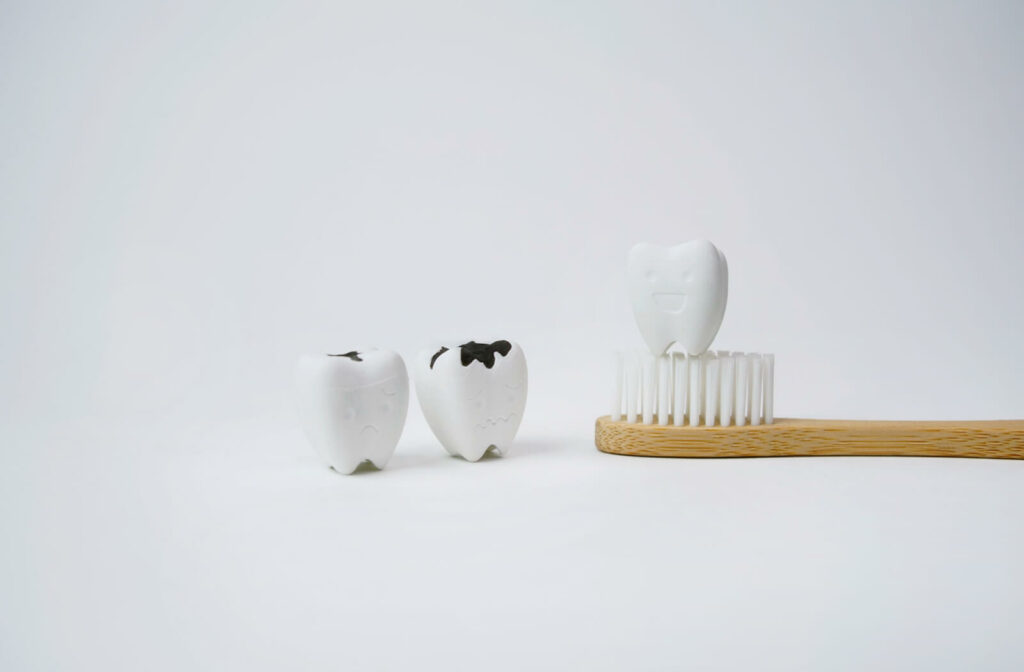Good oral hygiene isn’t difficult to accomplish, but it can sometimes be hard to stick to good habits when life gets busy. Unfortunately, even when adhering to a dentist-recommended schedule for teeth exams and cleanings, sometimes tooth decay can get away from us. And if left unchecked, this tooth decay can begin causing problems in our mouth, from infection to cavities.
Technically you cannot reverse tooth decay. However, you can reverse its effects to a certain degree. But suppose you let it go past the point of demineralization. In that case, you’ll likely need some form of restorative dentistry, such as fillings or a root canal.
What Is Tooth Decay?
Our mouths are filled with bacteria—some good, some bad. When we consume sugary food and drinks, harmful bacteria leave a sticky film on our teeth called plaque. And if left uncleaned, the plaque begins to damage our teeth.
The hard, protective coating that each tooth has is called enamel. This is one of the first things that the plaque begins attacking. The damage happens as a result of a process called demineralization. As the enamel is demineralized, it gets softer until the plaque starts creating tiny pits in your teeth called cavities.
Once you have a cavity, the bacteria in your mouth can access your tooth’s inner and more sensitive parts. Not only will the cavity grow in size, but also in depth. It will keep sinking further into the tooth until it reaches the pulp. If allowed to get this far, the only solution is often a root canal or tooth extraction.
Reversing the Effects of Tooth Decay
Technically, by stopping the demineralization process, you’re reversing the tooth decay process. More accurately, you’ve prevented the tooth decay from damaging the tooth. However, it is important to get rid of the tooth decay, or it will simply resume damaging your tooth again.
If you’ve caught it early enough, stepping up your oral hygiene routine and following your dentist’s recommendations may be enough to get rid of and stop the damage from tooth decay. Remineralization is a natural process where fluoride from toothpaste and minerals found in saliva work to strengthen tooth enamel and can restore the tooth’s surface before a cavity develops.
If a cavity forms, a visit to the dentist is required to restore the tooth.
When Tooth Decay Cannot Be Reversed
Once the tooth decay has progressed enough or a cavity has started developing on your tooth, unfortunately, there is no way to reverse it, and your dentist will have to deal with the issue for you. In many cases, a filling is adequate treatment. Another option may be a crown, depending on how extensive the damage is and where it’s located.
Whichever treatment your dentist deems the best for your situation, they all require the dentist to remove the decaying material to prevent it from spreading. This is typically done by drilling out the decayed part of the tooth.
Solea Laser Dentistry
Many people get anxious at the simple thought of having their mouth frozen and the dentist working in there with a drill (no matter how controlled and small it is). Thankfully we’ve got access to some incredible technologies and treatment tools nowadays.
Solea laser dentistry is one such advancement. This treatment system is incredible for those who suffer from dental anxiety (yes, that’s a thing). Instead of using a drill to remove the decaying material, a CO2 dental laser produces an intense beam of light energy that does the removal.
This treatment is virtually painless, making it a great option for those who have had a negative experience or kids.
How To Prevent Tooth Decay
Solea laser dentistry is a great option should you need tooth decay removed from your mouth. However, you should ideally be preventing tooth decay and cavities from developing in the first place.
Fortunately, it’s not hard to do. Here are several tips for preventing tooth decay:
- Brush your teeth at least twice a day with fluoride toothpaste.
- When brushing, spit rather than rinse to allow the fluoride to sit on your teeth.
- Floss at least once a day, preferably throughout the day after meals.
- Avoid sugary and acidic foods and beverages.
- Reduce alcohol consumption to avoid encouraging bacterial growth in your mouth.
- Avoid smoking (your whole body will thank you).
In addition to all these things, the Canadian Dental Association also recommends that you see your dentist every six months for a dental exam and cleaning. This is one of your best defences because your dentist may catch tooth decay before you notice it and advise you on its treatment.
Find Out More About Your Tooth Decay Treatment Options
If you’re beginning to show symptoms of tooth decay, such as sudden discomfort, odd-coloured spots on your teeth, or tooth sensitivity, then it’s time to see a dentist. When treating any issues in your mouth, sooner is always better than later.
Give our office a call today. The professional staff at Hometown Dental are happy to answer all your questions or book you in with one of our dentists.





